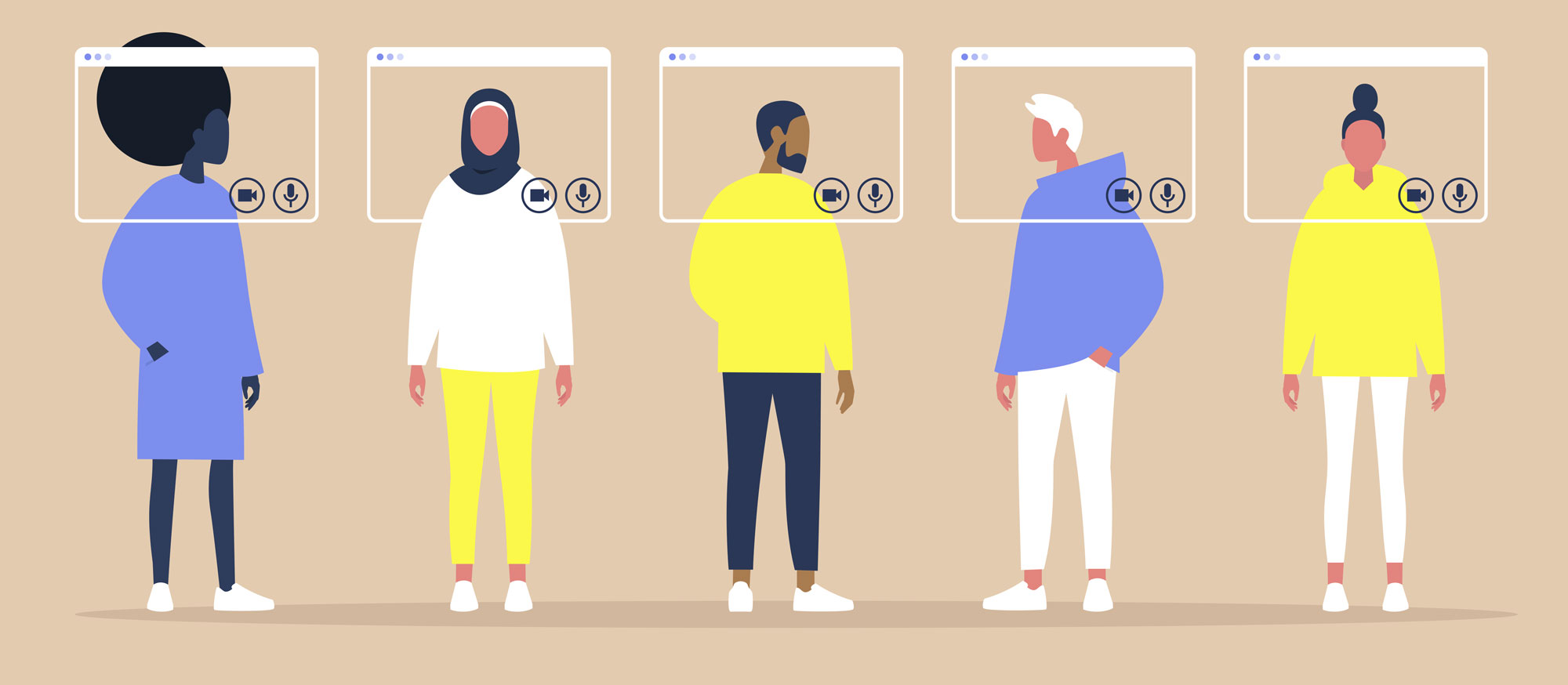
As the coronavirus outbreak spread throughout the globe, and New York City went into an unprecedented lockdown, we were forced to upend everything we knew about delivering a legal education. Faced with a disruption to our academic mission unlike anything we had ever experienced in the Law School’s history, our faculty and students rallied to transition from classroom learning to an entirely virtual curriculum. I could not be more proud of the dedication and the resilience of our academic community.
—Dean Matthew Diller




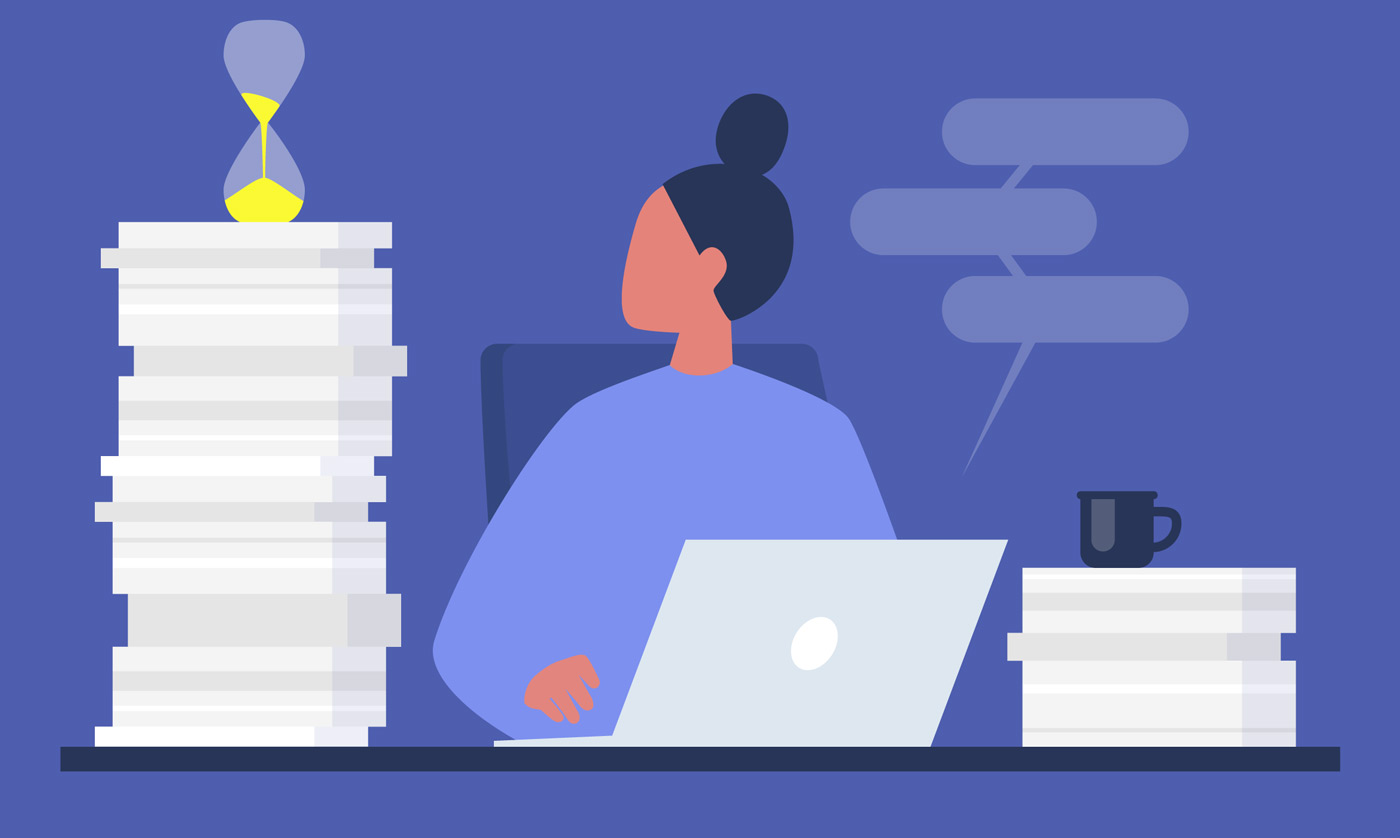



“… We are all in this together, and it must continue to feel that way both physically and psychologically. The relationships made during law school will last long into the future, and we rely on each other for strength on some of the hardest days.”
Juan Carrillo ’20
Sugin: Many of our students experienced serious hardships as a result of the crisis, including illness, housing issues, and severe financial constraints. We are incredibly grateful to the Fordham Law Alumni Association for acting quickly to respond to this urgent need and establishing the FLAA Student Emergency Fund, which provided crucial relief to students.
Denno: I was teaching criminal law to first-year evening school students, and I was really impressed by their incredible resilience. Most of my students were employed and some were in the medical or public health fields. By the time we entered lockdown, some of the students were losing their jobs while others were working longer and harder than ever. Others still were on the front lines of the COVID-19 crisis. One student, for example, was a nurse working more than 12-hour shifts handling COVID-19 patients. At least 10 percent of my students contracted COVID-19 on the job or at home because they were living with someone infected. So this was a tough time and I was inspired by my students’ strength and adaptability.
Brudney: I was impressed, even awed, at how well prepared, persistent, and thoughtful the students were through the semester. It really matters for this kind of online learning that the people who are on call are prepared and thoughtful. Even when they were struggling with an answer and they’re not always 100 percent accurate, they were really diligent and persevering.



“… It’s the same difference between dating online and dating in person, right? You just have a lot less information when you meet someone online than you do when you’re in person.”
Aaron Saiger

“Ironically, Zoom has opened up the conversation … I have different people contributing than those who were asking questions earlier in the session. The ‘usual suspects’ are not dominating like they used to.”
Tanya Hernández
Denno: I tried to make my online teaching as status quo as possible because so little was constant at the time, and I thought my students would appreciate the stability. So, for example, I continued to cold-call students on Zoom and conduct a highly interactive discussion in the way I had done before lockdown. Interestingly, a number of students who didn’t typically speak as much when we met face-to-face communicated a lot more when they were online, perhaps because they felt there was more freedom or less scrutiny. But I also instituted some marked changes—relying, for example, on asynchronous pretaped lectures to cover some of the more technical material. I found these recordings a more effective vehicle than teaching face-to-face, and I will probably do it again.
Brudney: I found I was giving the most detailed comments I could on papers. This is the students’ legal education. They’re investing in it, and I want it to be as close as possible to what they would have otherwise had.

Hernández: In seminars, because of their smaller size, you can almost simulate what you do in the classroom, but larger classes are another story. I have 90 students in my Trust and Wills class, so it’s impossible for me to pretend that everything is the same except that we’re online.
Huntington: In the physical classroom, I can immediately get a sense of whether people are paying attention, whether they’re confused, and whether they are challenged. It’s much harder to read the room online.
Brudney: When I’m teaching a live class and looking out over a sea of faces, I can usually tell if I’ve lost some students. When teaching online, it is not quite like being able to observe everyone and interact with them, or knowing when someone feels tense about something, I can try to “lower the temperature.” There are times when you need to be able to see the class in front of you.
“Many of our students experienced serious hardships as a result of the crisis, including illness, housing issues, and severe financial constraints. We are incredibly grateful to the Fordham Law Alumni Association for acting quickly to respond to this urgent need and establishing the FLAA Student Emergency Fund, which provided crucial relief to students.”
Linda Sugin
Saiger: I use this analogy a lot with my students, but it’s the same difference between dating online and dating in person, right? You just have a lot less information when you meet someone online than you do when you’re in person. So that’s a real problem. And you don’t necessarily feel like you’re getting all the follow-up questions. You’re not sure they’re hearing you. Some people are having technical difficulties. Their little siblings are making noise, or their roommate is cooking dinner, or their partner is on her own Zoom trying to have a meeting in the same tiny New York apartment. So, one of the goals for the fall is going to be to make it clear to students that they are really responsible for minimizing distraction as much as they possibly can. Even though that means they will sometimes feel bored, because sometimes you feel bored in regular classes too. That’s the price of not being distracted.
Huntington: I miss the immediate feedback of the real-life classroom. If I tell a joke on Zoom, I can’t hear them laughing because everyone is muted. Zoom mediates human contact.
Hernández: Ironically, Zoom has opened up the conversation as opposed to reducing it, as people feared might happen. I have different people contributing than those who were asking questions earlier in the session. The “usual suspects” are not dominating like they used to.
Huntington: Definitely the chat function, which I used a lot. When I ask a question in a physical classroom, only a few students can answer because of time constraints. Online, I can ask a question of the whole class and have everyone write a one-sentence answer in the chat function. That means I get 59 answers in the space of a minute. It’s a remarkably efficient way both to make sure everyone is involved and quickly take the pulse of the room.
Hernández: I found that students formulate more targeted, focused, and interesting questions when they have to write them down.
Denno: As a result of this experience, I can see recording a portion of my class going forward—perhaps 15 minutes or so—where I convey some of the really dense, intricate material in a format that students could play over and over. This approach would make it so that our Socratic method and our dialogue would be all the richer.
Hernández: A thing I’ve added now that I’m more comfortable with this is that I’ve started to pose questions to the class in the class agenda placed on the Zoom screen, as opposed to using the polling feature. So, in lieu of cold-calling, I’ve set up initial thought questions that are meant to start the students homing in on the core issues we are taking on that day. It gives them a sense of how everyone else is thinking about the question, and then I’ll integrate their responses into the conversation. This means everyone still has to do something, as opposed to just sitting there. The feedback from students is that they feel it’s the closest to being in class.

Saiger: It’s shaking us up. Even though this is not a desirable situation—and we will all want to return to in-person teaching as soon as we can—there are aspects of what I’ve been doing that I haven’t thought about in 10 years that I’m thinking about now. And even though it’s because there’s this unfortunate emergency, the exercise of starting from the beginning is positive.
Huntington: After finishing the spring semester, I came away convinced that online classes can work quite well, but only if we adapt our teaching styles to the online environment. In the physical classroom, I emphasize hands-on learning, with students doing small group work, participating in exercises, and so on. I found that this translated well to online classes but only with conscious effort. I organized my class notes to ensure that the entire class was doing something interactive approximately every 10 minutes. Often these were simple steps, such as answering a poll or typing a long-form answer into the chat box, but I also did more structured exercises that required breakout rooms and considerable collaboration.
Hernández: This experience has almost been a sort of reset or refresh. Some of the things I’ve been doing with regards to learning, access, and intelligibility, I realize I could keep doing—like the creation of class agendas—when we return to teaching students in person.

Photos by Chris Taggart
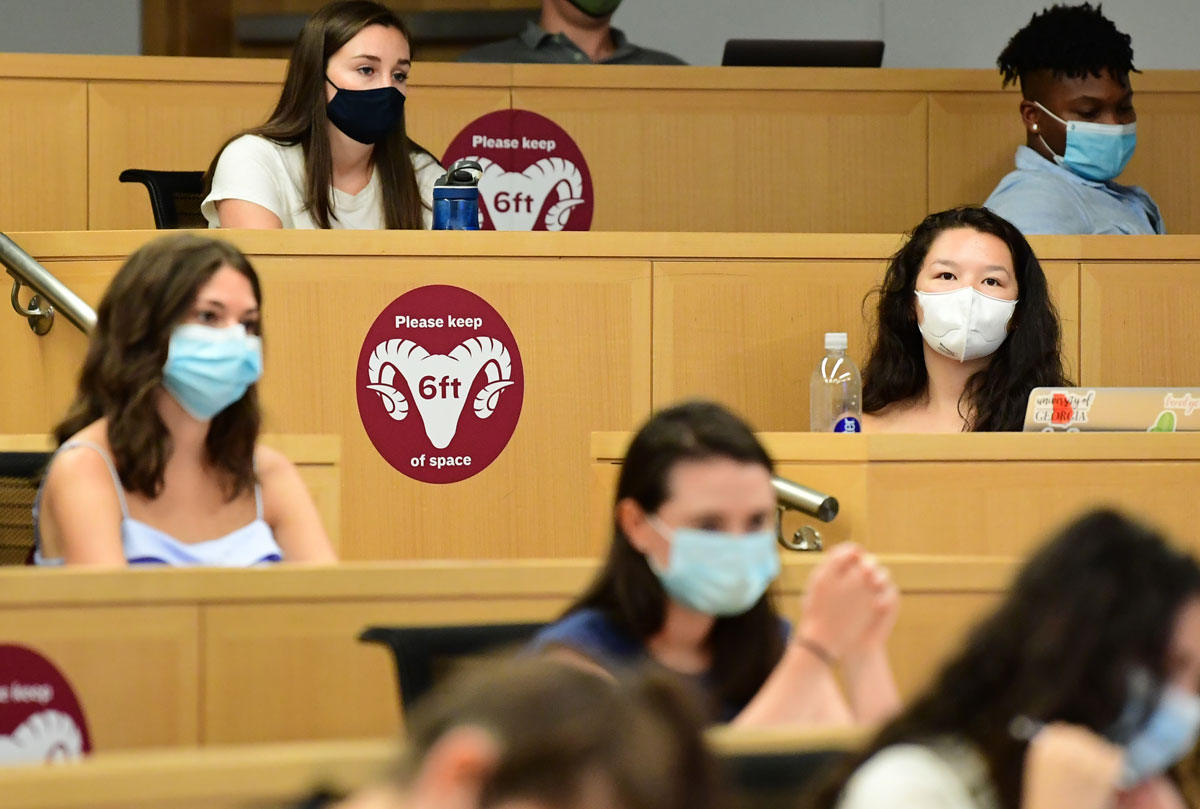

Professors Ted Neustadt (left) and Martha Rayner (bottom right) conduct in-person orientation classes.
Photos by Chris Taggart
Photos by Chris Taggart
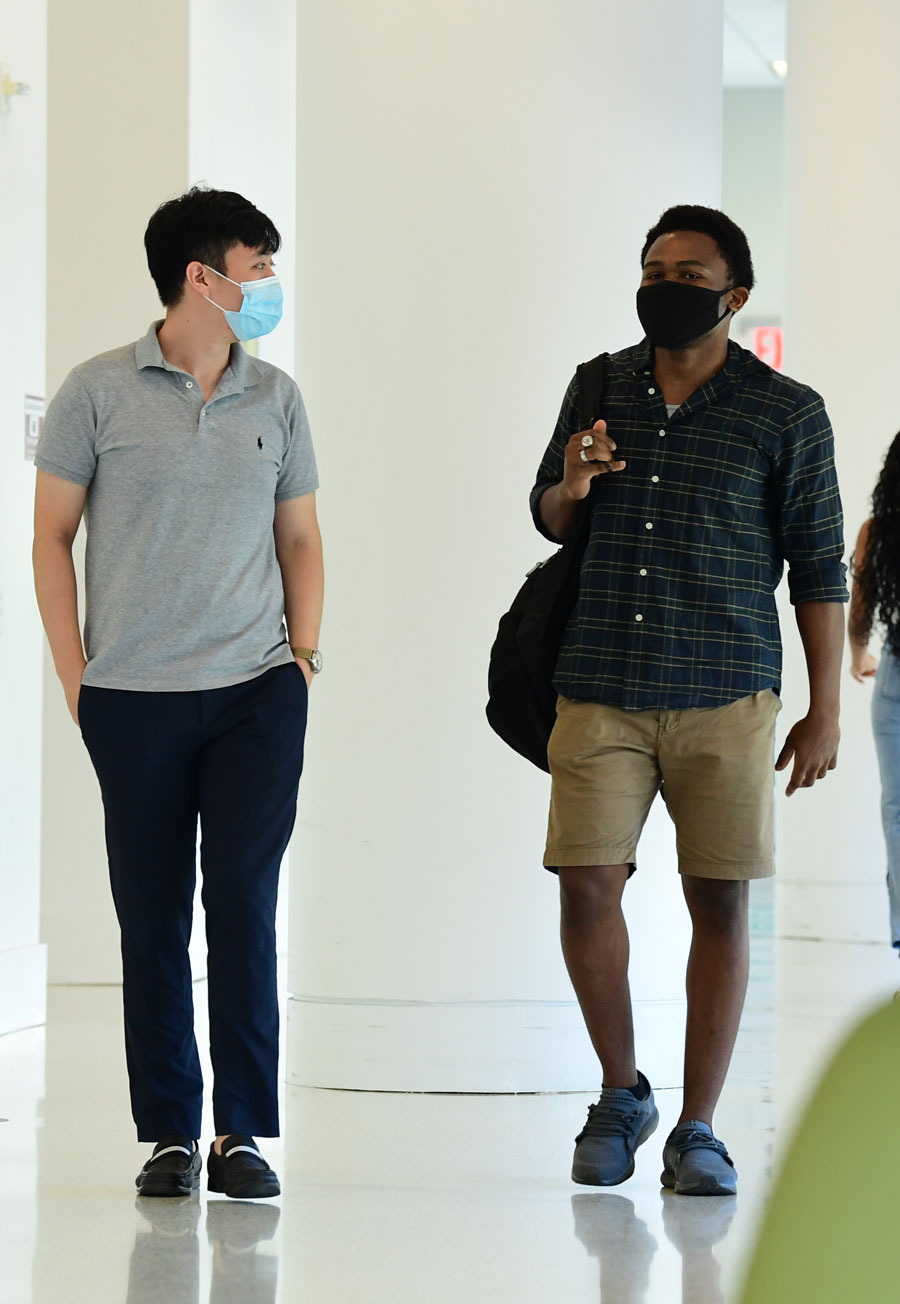
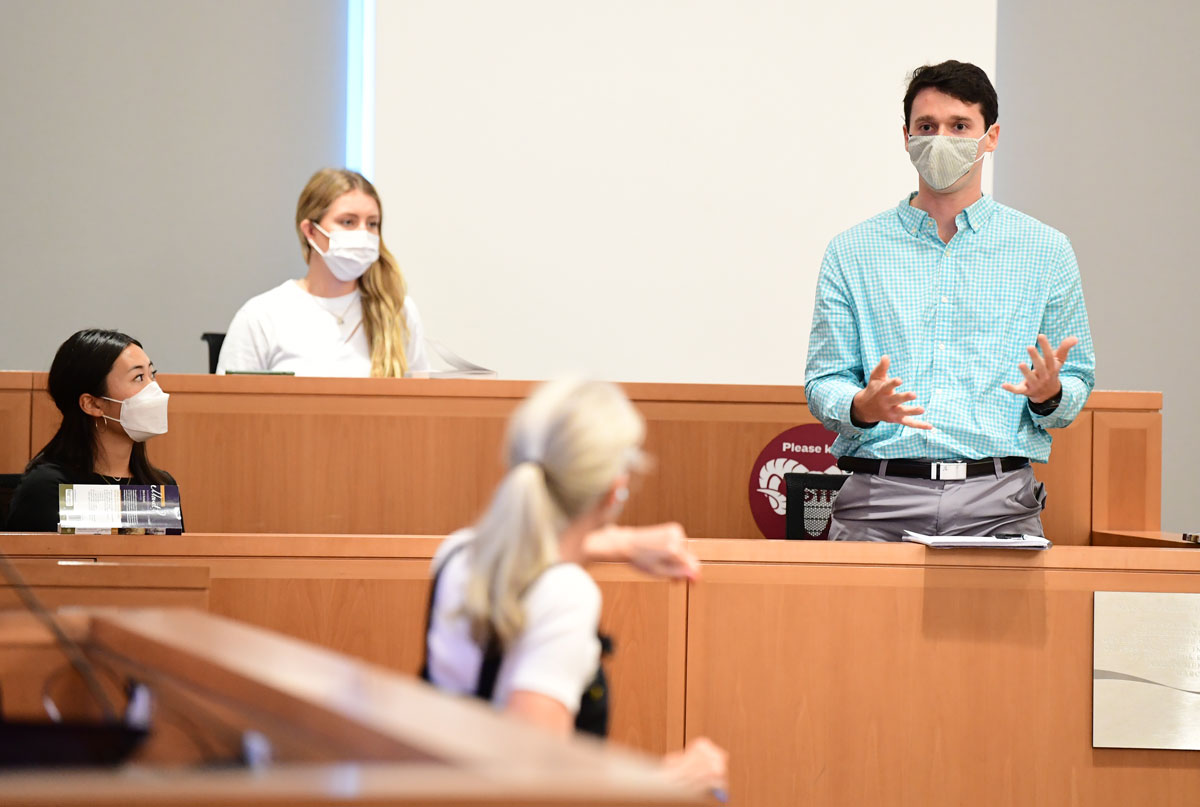
Photos by Chris Taggart
“I think the very immediate change— teaching radically differently within less than 24 hours—really forced us out of our teaching shells. There’s nothing like an emergency to flip a teaching paradigm.”
Deborah Denno
Huntington: The biggest challenge for the fall is figuring out how to establish a relationship with students when classes are either partially or fully online or when everyone is physically in a room together but sitting far apart and wearing masks. In the spring, we had the benefit of eight weeks of classes in person. By that point in the semester, I know my students well, I have established a rapport with them, and they know what to expect from me and what I expect from them. By contrast, I anticipate that it will take more of an effort to get to know my students during the fall. For this reason, I am planning on several approaches, including small group meetings and an online questionnaire at the start of the semester so I can learn more about my students as people and their aspirations as lawyers.
Carrillo: The new normal must include two things: time management that fits everyone’s individual needs and continued social interactions. Law students have so much on their plate to do as it is, so my hope is that remote instruction gives them the space and time they need to truly organize their schedule to fit their needs. Also, finding ways to stay present and engaged with fellow humans dealing with the same stressors is key. We are all in this together, and it must continue to feel that way both physically and psychologically. The relationships made during law school will last long into the future, and we rely on each other for strength on some of the hardest days. Some things just can’t be replicated with computers, and human interaction is one of them.